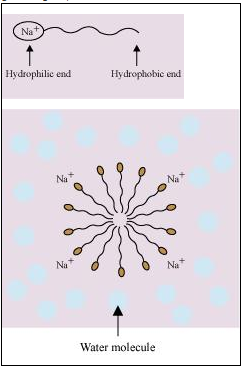A:
Sols are colloidal systems in which a solid is dispersed in a liquid. They are of two types:
(i) Lyophilic sols (solvent loving):
They are those in which the dispersed phase exhibits a definite affinity for the dispersion medium (liquid) or the solvent. For example: Dispersion of starch, gum & protein in water. The affinity of sol particles for the medium is due to hydrogen bonding with water (dispersion medium). They may have little or no charge at all & they donot exhibit Tyndall effect. These sols are reversible in nature i.e., if two constituents of the sol are separated by any means (such as evaporation), then the sol can be prepared again by simply mixing the dispersion medium with the dispersion phase and shaking the mixture.
(ii) Lyophobic sols:
They are those in which the dispersed phase has no attraction for the dispersion medium or the solvent. For example: Dispersion of gold, iron & sulphur in water. Their colloidal sols can be prepared only by special methods. The particles carry positive or negative charge& they do exhibit Tyndall effect. These sols are irreversible in nature.
Now, the stability of a lyophobic sol is due to the adsorption of positive or negative ions by the dispersed particles. The repulsive forces between the charged particles donot allow them to settle.If some how ,the charge is removed, there is nothing to keep the particles apart from each other. They aggregate or flocculate & settle down under the action of gravity. In lyophobic sols,they are not surrounded by adsorbed layer of dispersion medium, as a result they come together & coagulate. So whenever an excess of electrolyte is added or boiling is done, the electrolyte furnishes both positive & negative ions in the medium & the sol particles adsorb oppositely charged ions & gets discharged. The electrically neutral particles then aggregate & settle down as precipitate. The stability of hydrophilic sols depends on two things- the presence of a charge and the salvation of colloidal particles. On the other hand, the stability of hydrophobic sols is only because of the presence of a charge. Therefore, the latter are much less stable than the former.










